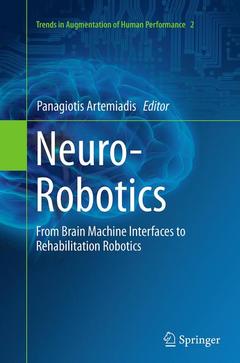Description
Neuro-Robotics, Softcover reprint of the original 1st ed. 2014
From Brain Machine Interfaces to Rehabilitation Robotics
Trends in Augmentation of Human Performance Series, Vol. 2
Coordinator: Artemiadis Panagiotis
Language: English
Subjects for Neuro-Robotics:
Publication date: 09-2016
Support: Print on demand
Publication date: 07-2014
448 p. · 15.5x23.5 cm · Hardback
Description
/li>Contents
/li>Comment
/li>
1 A Learning Scheme for EMG Based Interfaces: On Task Specificity in Motion Decoding Domain.- 2 State of the art and perspectives of ultrasound imaging as a human-machine interface.- 3 Considering limb impedance in the design and control of prosthetic devices.- 4 Multi-axis Capability for Powered Ankle-foot Prostheses.- 5 Mimicking human-like leg function in prosthetic limbs.- 6 Multi-directional dynamic mechanical impedance of the human ankle; a key to anthropomorphism in lower extremity assistive robots.- 7 Development of the Quantified Human.- 8 Optimal Neural Representations for Brain-Mediated Human-Robot Interactions.- 9 Assisted Computer Interaction for Users with Weak Upper Limb Motion.- 10 Robotic Systems for Gait Rehabilitation.- 11 Enhancing recovery of sensorimotor functions: the role of robot generated haptic feedback in the re-learning process.- 12 Robotic Assistance for Cerebellar Reaching.- 13 A Human Augmentation Approach to Gait Restoration.- 14 Home-based rehabilitation: enabling frequent and effective training.- 15 Unilateral and Bilateral Rehabilitation of the Upper Limb Following Stroke via an Exoskeleton.- Index.




